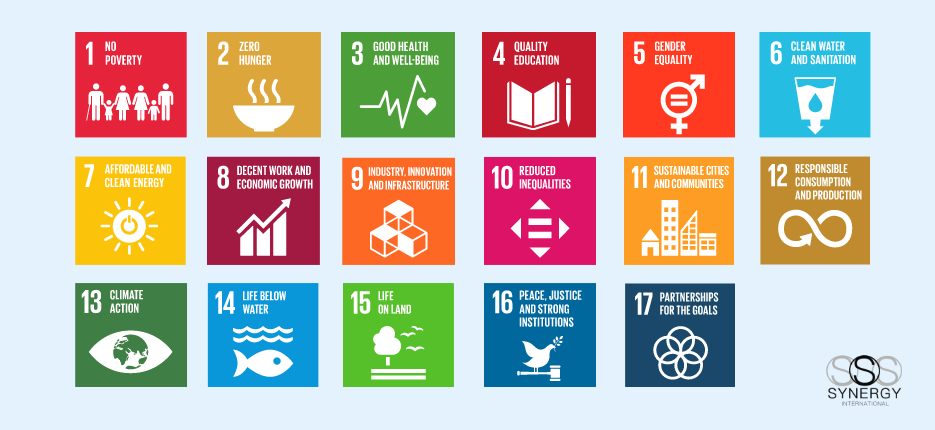SDGS - Sustainable Development Goals

As global attention turns to critical environmental policy discussions, Synergy International is committed to supporting our partners by offering insights into the legal frameworks that guide sustainable resource management. From the United Nations Convention on the Law of the Sea (UNCLOS) to the Paris Agreement, these treaties not only shape international environmental law but also impact the business and regulatory landscapes in profound ways.
Sign up for the Green Wave newsletter to ensure you stay informed and connected with the latest developments in global sustainability governance.
When were the SDGs created?
When were the SDGs created?
The Sustainable Development Goals were established in 2015 by the UN as part of the 2030 Agenda for Sustainable Development.
What does SDG mean and how many SDGs are there?
What does SDG mean and how many SDGs are there?
SDG is short for Sustainable Development Goal. There are seventeen SDGs.
The SDGs represent an integrated approach to addressing the world’s most pressing challenges, supported by a wide array of international treaties and legal frameworks. These agreements foster cooperation and accountability, ensuring that countries work collectively towards a sustainable and equitable future. By leveraging these legal regimes, the global community can advance the SDGs’ ambitious vision for 2030.
Foundations of the UN Sustainable Development Goals: International Treaties and Legal Regimes
The UN SDGs, Sustainable Development Goals, are built on a foundation of international treaties and multilateral agreements that promote sustainable development. These frameworks guide global efforts toward social, economic, and environmental sustainability, ensuring coherence in international law and policy. The legal regimes supporting the SDGs address a wide array of global challenges, from climate change to poverty.
1. United Nations Charter and Millennium Development Goals (MDGs)
The United Nations Charter of 1945 laid the groundwork for international cooperation in maintaining peace and security, advancing human rights, and promoting social and economic development. This established the UN as the leading body in global development initiatives.
Before the SDGs, the Millennium Development Goals (2000-2015) provided an earlier framework for addressing global issues like poverty, hunger, and health. The SDGs expanded on these, incorporating environmental sustainability and a broader range of economic, social, and political issues into the global agenda.
2. Paris Agreement and Climate Change
A cornerstone of the SDG framework is the Paris Agreement on climate change, adopted under the United Nations Framework Convention on Climate Change (UNFCCC). This legally binding international treaty, signed by 196 nations, is pivotal in supporting SDG 13 (Climate Action) as well as SDG 9 (sustainable industries and infastructure) and SDG 7 (Clean Renewable Energy). The Paris Agreement commits countries to limit global temperature rises to well below 2°C and pursue efforts to limit it to 1.5°C. The agreement strengthens the environmental dimension of the SDGs, particularly in areas of reducing carbon emissions and advancing renewable energy initiatives.
3. Convention on Biological Diversity
The Convention on Biological Diversity (CBD), adopted in 1992, is a key international treaty influencing SDG 14 (Life Below Water) and SDG 15 (Life on Land). It focuses on the conservation of biological diversity, the sustainable use of its components, and the fair sharing of benefits arising from genetic resources. The CBD aims to promote sustainable practices that safeguard ecosystems and biodiversity, crucial for maintaining a balance between human activities and environmental protection.
4. International Labour Organization Conventions
Various conventions of the International Labour Organization (ILO) underpin SDG 8 (Decent Work and Economic Growth). These include the promotion of labor rights, gender equality, and the elimination of child labor. The ILO conventions ensure fair and equitable working conditions, critical for reducing inequalities and fostering inclusive economic growth. They contribute to creating a global labor market that supports sustainable development through social justice and human dignity.
5. International Covenant on Economic, Social and Cultural Rights
The International Covenant on Economic, Social and Cultural Rights (ICESCR), adopted in 1966, supports multiple SDGs, particularly those concerning poverty eradication, education, and inequality (SDGs 1, 4, and 10). This covenant obliges states to respect, protect, and fulfill the rights to adequate food, water, health, education, and decent living standards—essential components of sustainable human development.
6. Basel, Rotterdam, and Stockholm Conventions
The Basel, Rotterdam, and Stockholm Conventions collectively support SDG 12 (Responsible Consumption and Production) and SDG 3 (Good Health and Well-Being) by regulating the transboundary movement of hazardous wastes, trade of hazardous chemicals, and reduction of persistent organic pollutants. These conventions ensure environmental safety, promote sustainable production patterns, and protect human health from toxic substances.
7. United Nations Convention to Combat Desertification
The UN Convention to Combat Desertification (UNCCD) is a critical international agreement supporting SDG 15 (Life on Land). It addresses land degradation and promotes sustainable land management, especially in arid regions. By focusing on reversing desertification, this treaty contributes to food security, poverty reduction, and the conservation of ecosystems.
8. World Trade Organization Agreements
While trade is not directly mentioned in the SDGs, the World Trade Organization (WTO) plays an essential role in fostering international trade policies that align with the SDG 17 (Partnerships for the Goals). WTO agreements on trade facilitation, agriculture, and intellectual property rights support the global economy and enable developing countries to participate in international markets, fostering economic growth and poverty reduction.
9. Agenda 21 and the Rio Declaration on Environment and Development
Adopted at the 1992 Earth Summit in Rio de Janeiro, Agenda 21 and the Rio Declaration on Environment and Development emphasize the importance of integrating environmental sustainability into all facets of development. These instruments laid the foundation for SDGs related to sustainable resource use and environmental stewardship, particularly SDG 12 on responsible consumption and production.
Sign up for the newsletter to get our special SDG series.
- Home
- SDGs
